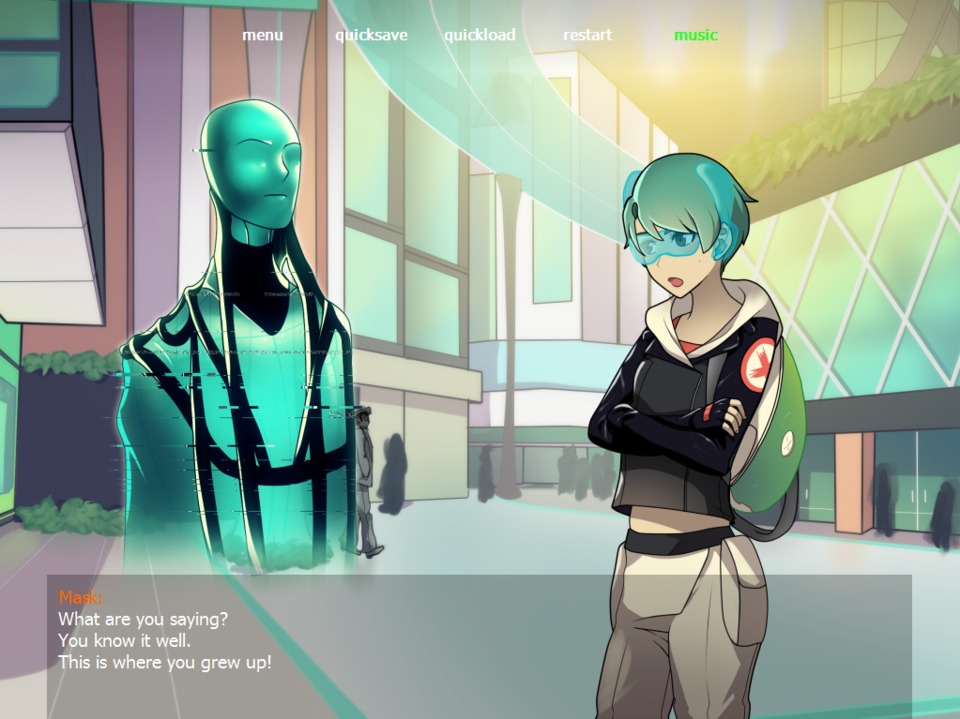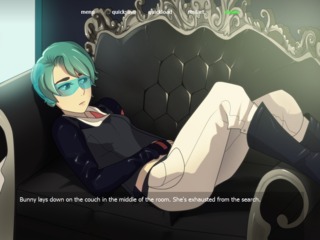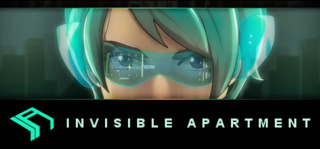Off the Grid
Invisible Apartment is a free sci-fi visual novel developed by Milan Kazarka and Jeroen van Oosten, and is a snapshot of the life of Bunny, a homeless girl wandering the futuristic city of New Jessica. Accompanied by Mask, the digital assistant living in her smart glasses, she takes on the city as a talented hacker, working her way through life one compromised network node at a time. Events for them take a big turn when they are lucky enough to stumble upon an apartment off the grid from the rest of city which begins a journey of personal exploration, newfound friendship, and techno-transcendentalism. That being said, this epic journey takes place within a rather brief time window, leaving the game feeling all too rushed.

Pacing and transitioning from one scene to the next are the areas in which the game feels the least capable. This is most sharply felt in its opening minutes during which it flashes between the relaxing solitude of a cafe, the franticness of escaping a crime gone wrong, a scene of panicked dejection, and then a lighthearted consideration of future plans. That issue is knocked up a couple of notches on the “Uncomfortably jarring” scale by the music immediately cutting out at the conclusion of scenes instead of gently fading. In a similar style there’s one music loop early on which drags you straight out of the moment by halting early every time it plays. Fortunately, in itself the game’s soundtrack is quite strong. An overly-cheesy soft rock song aside, it’s one of the standout positives here. There’s some gentle guitar, some hard-hitting cyberpunk synth, and a couple of soft, beautiful Erik Satie pieces. The art, sadly, isn’t quite of the same quality.
Despite calling itself a cyberpunk game, Invisible Apartment actually presents a fairly lively and optimistic future. The city of New Jessica looks like it has less to do with the Tyrell Corporation and more to do with Google, and while there’s some element of shadowy, oppressive authority lurking around the corners, most of the places and people you encounter are non-threatening or at least represent a fairly functional society. This game might not be the glistening utopian vision you’re picturing however, as while the artwork in the game was obviously produced with some skill, it retains a rather amateur look. In addition, the menu consists of unpolished text constantly applied over the top section of your screen which feels outright unfinished, and then there’s the writing which is full of all sorts of unusual mistakes.

One unexpected source of disorientation is that the game has a habit of referring to Bunny in third-person until you hit one of the few story choices, at which point you start taking decisions for her in the first-person. You can also feel the author fumble with how exactly to convey much of both the concepts unique to this sci-fi world and the emotional state of the characters. When Invisible Apartment has, for example, a technology to explain, it’s common that instead of seeing a character use it or talk about it in any natural way, a flashcard will pop up on the screen with info on that technology, as though you were reading some sort of game wiki. Alternatively, the characters might have the kind of overly-explanatory conversation about the basic use of a piece of technology that people in the real world never have. And when the script isn’t pragmatic discussion of techno-futuristic plans about scanning wireless access points and exploiting hacked locks, it often skews into characters suddenly and all too openly laying bare their innermost feelings. There are occasional quieter moments and some playful back and forth, for example in a semi-serious spat between Mask and Bunny, or the slightly intriguing tension between Bunny and a character she meets further in, and these things benefit the game, but it feels like because the narrative has such a cramped space in which to play out all of its ideas it has to clumsily dump everything it has in a hurry, bombarding you with its arsenal of emotion and plot before hitting an abrupt stop.
The rather strange thing is that it doesn’t even feel like Invisible Apartment needs to expend all that energy so quickly. A brief look at the game’s website tells you that this is meant to be a multi-part series and you certainly feel that in the game’s ending. Why then they’d jam so much into this initial short snippet becomes a bit of a mystery. The game would be better off if it just took one or two plot points it wanted to focus on and ran with them, instead of trying to be the first act of a novel in bite size form. For all these gripes however, the game's ambitious, and the way you are always facing something new every couple of scenes at least keeps the story up and active instead of lapsing into lethargy. Invisible Apartment feels like a rather wet proof of concept instead of a full and rich game in itself, but as such it becomes a bit of a fascinating curio. It’s a game that’s forgettable, but with enough in it to retain some charm and friendliness.
